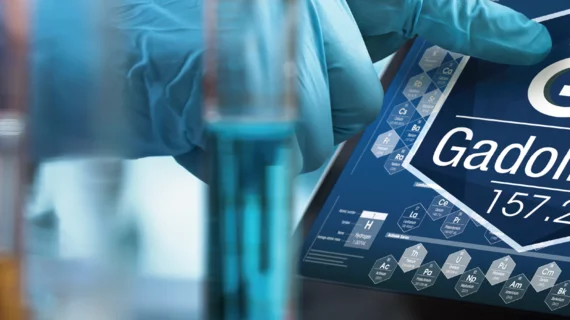Allergic reactions to iodinated CT contrast increase likelihood of sensitivity to GBCAs
Patients who have a history of allergic-like reactions to iodinated contrast media used for various CT procedures are also at an increased risk of adverse reactions to MRI contrast agents.
Until recently, the hypersensitivity reactions (HSRs) to the two different imaging agents had never been associated, but new research published this week in Radiology is challenging that theory.
Various CT procedures take advantage of the increased visualization that iodinated contrast media offers, and reactions to its administration are rare and typically very mild. Likewise, MRI studies utilize gadolinium-based contrast agents (GBCAs) to produce more detailed depictions on imaging. While GBCAs are also considered relatively safe, as they are becoming more widely used, more instances of adverse reactions are emerging.
“Recent studies have reported several adverse reactions related to their use, including nephrogenic systemic fibrosis and allergic-like hypersensitivity reactions,” senior author Hye-Ryun Kang, MD, PhD, from the department of internal medicine at Seoul National University College of Medicine in Seoul, Korea, and co-authors explained. “As the use of GBCAs continues to increase in the clinical setting, it is important to be aware of the adverse reactions associated with their use and to be able to identify potential risk factors for such reactions.”
As a result of their research, which analyzed 331,070 cases of GBCA exposure in 154,539 patients, experts were able to pinpoint specific risk factors for reactions to the contrast agent.
In general, acute HSRs (reactions within an hour of exposure) were rare, occurring in only .4% of cases. Delayed reactions (happening typically within one week of exposure) were even more rare and were noted in only .04% of cases.
Patients who had a history of HSRs to iodinated contrast were at an increased risk of recurrence when exposed to GBCA, as were individuals with repeated use of the MRI contrast. When those patients were either pre-medicated with antihistamines or were switched to a different GBCA, their risk of recurrence dropped significantly.
The increased recurrence rate for patients with a history of HSRs could be the result of their individual underlying susceptibility to drug allergies, which is why thorough documentation of patients’ histories is so important, experts noted.
“In all patients undergoing MRI with GBCA exposure, a detailed history of previous HSRs should be conducted, and when necessary, appropriate prevention measures such as using premedication and switching to a different type of GBCA should be implemented,” the authors concluded.
Related MRI Contrast Agent Safety Content:
A deep dive into gadolinium-based adverse reactions
Researchers detail data on gadolinium-related adverse reactions
Radiologists must take a data-driven approach to discuss gadolinium, mitigate liability risk
Radiologists see potential to reduce GBCA administration with new synthetic MRI technique
Gadolinium-based contrast agents are safe, even at higher doses, new research suggests
Gadolinium debate rages on, with radiologist questioning recent GBCA liability guidance
ACR committee proposes new term for symptoms associated with gadolinium exposure
Closing the knowledge gap on gadolinium retention risks
Radiologists find direct evidence linking gadolinium-based contrast agent to higher retention rates
AI software that eliminates need for gadolinium contrast during imaging exams wins patent
Research may offer new method to detect GBCA on MRI
Radiology, other multispecialty groups urge caution with GBCAs during interventional pain procedures
Cardiac MRI contrast agents are low-risk and safe for ‘overwhelming’ majority of patients
Health orgs publish special report about gadolinium retention, GBCA use in imaging
Rodent brains retain gadolinium after repeated administration of GBCA a year after injection
Advanced MRI mapping spots traces of gadolinium in the brain invisible during conventional scanning
Radiologists should keep patients’ best interests in mind to mitigate gadolinium liability risk

